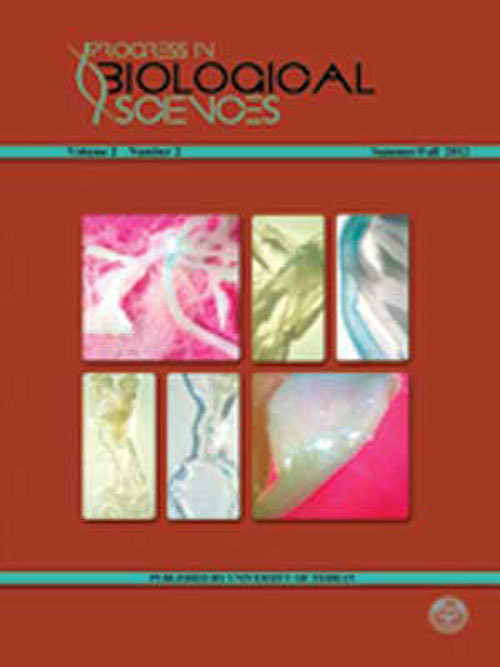فهرست مطالب
Progress in Biological Sciences
Volume:1 Issue: 1, Winter and Spring 2011
- تاریخ انتشار: 1390/04/28
- تعداد عناوین: 8
-
-
Page 1To investigate the impact of overexpression of AtNRT2.1 transgene from Arabidopsis on nitrate uptake rate and to understand the regulation of endogenous HATS by nitrate and glutamine amino acid (Gln) in tobacco plants, wild-type and transgenic (F line) plants grown on soil for 4 weeks were transferred to hydroponic culture in a controlled-environment with a 16/8h L:D photoperiod at 24? C/20? C, 70% relative humidity and 150? mol. m-2. s-1 light intensity. Nitrate uptake over time was studied by the ion depletion method. Nitrate uptake in the 2 h exposure to 150? M nitrate showed an increase in the transgenic line compared to the wild-type plant. Subsequently the uptake trend followed a similar pattern in wild-type plant and transgenic plants
-
Page 11Development of potent new anti-Shigella agents for rapid and specific detection and treatment is of great importance. Aptamers, nucleic acid oligomers capable of specific binding to a wide range of non-nucleic acid targets, may be of value for this purpose. In the present study, we used a Systematic Evolution of Ligands by Exponential enrichment (SELEX) process to select DNA aptamers that bind to whole S. sonnei cells. The resulting aptamers exhibited specificity in binding only to S. sonnei cells. Five unique DNA sequences were isolated from the aptamer cocktail by cloning, among which ASA4 showed the highest affinity.
-
Page 17Transformation of plants using Agrabacterium rhizogenes may affect secondary metabolite production as well as morphological changes. In this study, T-DNA from Ri plasmid in A. rhizogenes carrying pRi15834-PRT35S-GUS was introduced into tobacco leaf segments to initiate development of transformed hairy roots. Plant regeneration from transgenic roots used MS medium, and plants regenerated from transgenic roots were subjected to 300 mM NaCl. Transgenic plants showed higher levels of salt tolerance compared to non-transgenic plants. This could be due to over expression of the AUX gene in transformed hairy roots and plants regenerated from transgenic roots.
-
Page 25In order to determine the age structure, growth, and length-weight relationship of the mudskipper, Periophthalmus waltoni, from coastal mudflats of Qeshm Island, Soroo and Bandar-pol, in Hormuzgan Province, Iran, we collected 192 individuals in February 2007. Age was determined using the second pectoral radial bone and year class was based on length-frequency distributions. Growth was described by the von Bertalanffy growth model. For Bandar-Pol mudskippers, = 141.51 mm, k = 0.46 year-1, and t0 = 0.79 year. For Qeshm mudskippers, = 166.79 mm, k = 0.42 year-1, and t0 = 0.62 year. Overall, males grew larger than females (= 208 mm vs. 147 mm), while females grew faster (k = 0.41 vs. 0.19 year-1). The age when the theoretical length was 0 (t0) was 1.46 year for males and 0.88 for females. Maximum age was estimated to be 4+ years.
-
Page 31Biodegradation of phenol is a major focus of toxic organic compound degradation by microorganisms isolated from polluted areas. An increasing number of bacteria and fungi possessing unique biodegradation capabilities have been isolated in recent years. In this study a new isolate, Rhodococcus erythropolis SKO-1, from polluted soils in the Tehran oil refinery region, is reported. Identification was performed by sequencing of 16S rDNA and confirmed by morphological and biochemical characterization. Phenol was consumed as the sole carbon source, and the ortho pathway was confirmed as the metabolic route of phenol biodegradation by the isolate. After adaptation, phenol degradation was approximately 99.64% of an initial concentration of 1000 mg phenol l-1 in 56 h. Enrichment of minimal salt medium by addition of yeast extract resulted in further phenol tolerance and increased phenol degradation capacity up to 1200 mg phenol l-1.
-
Page 41The genus Ranunculus L., with a worldwide distribution, is the largest member of the Ranunculaceae. Here, nuclear ribosomal internal transcribed spacer (ITS) sequence data and chloroplast trnLF sequence data were used to analyze phylogenetic relationships among members of the annual and perennial (Group Praemorsa, Group Rhizomatosa, Group Grumosa and Group non-Grumosa) species of Ranunculus in Iran. In the strict consensus tree of nrDNA ITS sequence analyses, seven sub-clades were described, based on morphological, karyological, palynological, and ecological features. Within each clade, there were species belonging to more than one Group, and species of a single Group may fall into different clades, revealing that a classification based on underground system characters does not show natural interspecific relationships and must be revised. This is also apparent from trnL-F sequence analyses. Based on our results, the Praemorsa and Rhizomatosa Groups can be merged.
-
Page 49Hybrids were produced by crossing female Caspian kutum Rutilus frisii kutum with male grass carp Ctenopharyngodon idella. The genome of eight larvae and parents were studied using microsatellite markers for genetic evaluation and verification. After DNA extraction from parent fish and progeny, hybrid heritability of two loci was assessed using two pairs of microsatellite primers. Hybridizied offspring showed as similar banding pattern to that of their maternal parent, without heritability of the paternal genome.
-
Page 55The late sexual maturity in sturgeon and the absence of morphological differences between males and females makes sex discrimination difficult. Identification of sex at an early life stage is of high interest in caviar production because it allows efficient selection of females. In this study, the genome of 10 mature male and 10 mature female specimens of Persian sturgeon (Acipenser persicus) and beluga sturgeon (Huso huso) were screened using AFLP and 100 primer combinations. Results showed a total of 3771 and 3779 scoreable bands in A. persicus and H. huso, respectively. Approximately 30% of markers in A. persicus and 29.6% H. huso were polymorphic. No sex specific makers were identified. The results of the present study suggest that the sex chromosomes are not extensively differentiated in sturgeon species, or possibly the methods utilized were not sufficiently sensitive to recognize them.


